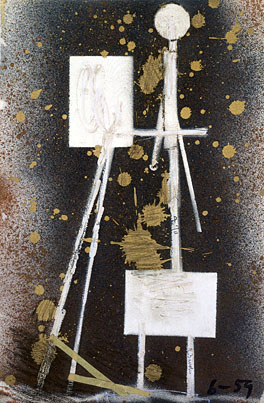
|
ABOVE: David Smith, 6-59, 1959. Spray enamel, graphite, gouache, and masking tape on paper, 17 5/8 x 11 5/8 inches. Philadelphia Museum of Art, Purchased with the Lola Downin Peck Fund and Carl and Laura Zigrosser Collection (by exchange), 2004.
Photo by Robert McKeever, courtesy Gagosian Gallery.
|
|
|






|
|
From the very beginning of his career as an artist, drawing was a daily activity for Smith. He produced hundreds of drawings each year, often exploring ideas that he later used in his sculpture, but also creating works largely unrelated to his three-dimensional oeuvre. His sculptural process was slow and difficult, and Smith remarked that drawing allowed him to maintain his free flow of artistic thought while he labored on his complex metal constructions; indeed, he kept two separate studios and frequently spent his days welding and his nights drawing. In 1953 he claimed, “These drawings are studies for sculpture, sometimes what sculpture is, sometimes what sculpture can never be. Sometimes they are atmospheres from which sculptural form is unconsciously selected during the labor process of producing form. Then again they may be amorphous floating direct statements in which I am the subject, and the drawing is the act. They are all statements of my identity and come from the constant work stream.”
Up until the early 1950s, many of Smith’s drawings were studies for sculptures he was considering or had already begun. These show the careful planning behind works that seem improvisational and indicate other directions Smith’s sculptures might have taken, but that for one reason or another he chose not to pursue. Around 1952, when he began to weld his sculptures in titled series and left behind much of the expressionistic symbolism of his early work, Smith’s drawings also underwent a significant change. Exploring open curvilinear forms related to the drawing-in-space method of his Agricolas, or vertical personage figures similar to his Tanktotems and Sentinels, Smith used his works on paper to consider possibilities foreclosed in his sculptural practice by simple physics. At the same time, employing egg-based inks of his own invention, he investigated the expressive quality of brushstrokes like those he would later apply to his metal surfaces. Finally, in the late 1950s Smith began using spray paint—then still a new medium—to create stenciled shapes out of negative space, in works closely tied to his late-career turn toward geometric planes and solids.
|